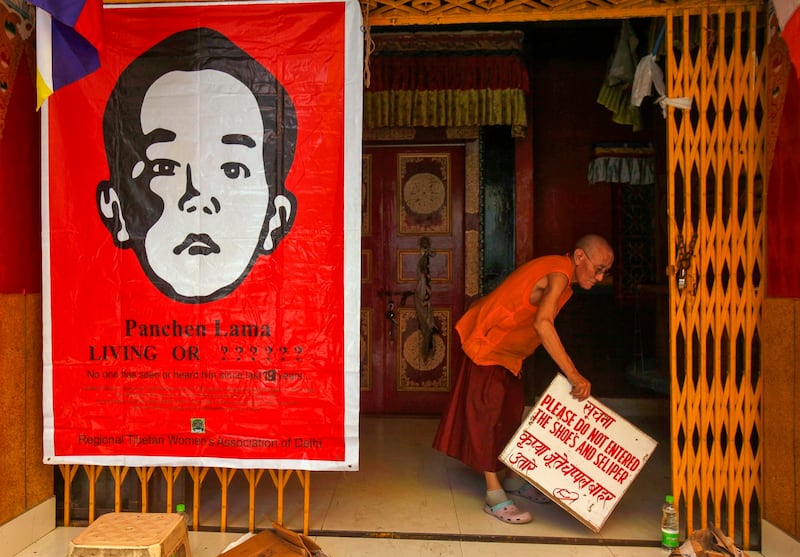The young boy who was abducted as a 6-year-old turned 36 on Friday.
What he does, where he lives or even if he’s still alive isn’t known, thanks to the reticence of the Chinese government, which kidnapped him along with his family and his teacher 30 years ago.
Beijing leaders, ever wary of potential rivals for the Communist Party’s authority, viewed the boy, Gedhun Choekyi Nyima, as a possible threat.
Days earlier the Dalai Lama had named him the 11th reincarnation of the Panchen Lama, the second-highest spiritual leader in the largest sect of Tibetan Buddhism.
Tibetans have long marked his birthday with celebrations held in absentia, and reiterated long-standing requests to Beijing to reveal Gedhun Choekyi Nyima’s fate.
The Panchen Lama’s abduction illustrates the sensitivity of Chinese authorities to other prominent religious figures amid their effort to control Tibetans by suppressing expressions of their Buddhist faith.
The fight over the 11th Panchen Lama is seen as a likely precursor to the battle over who will succeed the 14th Dalai Lama, who turns 90 this year.
China, always wary of opposition to its authority, particularly in the restive Tibetan region, says it can appoint the successor under Chinese law. But the Dalai Lama said, in a new book, that his reincarnation will be born in the “free world,” which he described as outside China.
Tibetan Buddhists believe the Dalai Lama and Panchen Lama are reincarnated when they die, and that they have the right to select the religious leaders based on their belief in the principle of rebirth.

Who is the Panchen Lama?
The word “Panchen” is based on a Sanskrit word for “Great Scholar.” Traditionally the Panchen Lama has played a leading role in Tibetan Buddhist scholarship as the leader of the Tashi Lhunpo Monastery in Shigatse, the second largest city in Tibet, which has been controlled by China since 1951.
Buddhists believe that the Dalai Lama is a physical representation of Avalokiteshvara, the Buddha of compassion, and the Panchen Lama of Amitabha, the Buddha of infinite light.
The two lamas share a special spiritual relationship, with each recognizing the other’s successive reincarnations and serving as the other’s teacher.
Tibetan Buddhists believe that the reincarnations of the Dalai Lama and the Panchen Lama are revealed through a series of tests as judged by prominent religious leaders.
The Panchen Lama’s most important responsibility includes finding and recognizing the reincarnation of the Dalai Lama in the event of his passing, one reason why China wants a Panchen Lama under its control.
What happened to the Panchen Lama?
On May 14, 1995, the Dalai Lama recognized Gedhun Choekyi Nyima as the Panchen Lama, the 11th reincarnation of his predecessor, who passed away in 1989 at the Tashi Lhunpo Monastery in Shigatse.
This angered Chinese authorities, who rejected the choice.
Three days later the boy, his family and his teacher were abducted. They have been missing ever since.
For 30 years, Tibetans, global leaders, and rights groups have called on the Chinese government to reveal their whereabouts, to no avail.

Who is the Beijing-appointed Panchen Lama?
Shortly after the abduction of the Dalai Lama-appointed Panchen Lama, Beijing installed another boy, Gyaltsen (in Chinese, Gyaincain) Norbu, as their own candidate in his place.
However, the Chinese government-appointed Panchen Lama remains unpopular with Tibetans both in exile and at home and is perceived as a “political tool” for Beijing.
Ordinary Tibetans and monks in monasteries traditionally loyal to the Dalai Lama have been reluctant to acknowledge or receive him, and during his visits to Tibet, Beijing has in the past handed out small monetary incentives for people who receive his blessing.
Significance of the Panchen Lama’s role
China’s appointment of Gyaincain Norbu as Panchen Lama underscores Beijing’s attempts to interfere in the selection of the reincarnation of the Dalai Lama, and gain control and legitimacy among Tibetans, both inside Tibet and in exile, say experts.
The move is also seen as China’s attempts to acquire more influence over Buddhism not only inside occasionally restive Tibet but throughout the Himalayan region. Beijing has increasingly looked to leverage religion as a soft power diplomacy tool across various Buddhist nations in South and Southeast Asia.
In 2007, the Chinese government decreed that China would begin overseeing the recognition of all reincarnate Tibetan lamas, or “Living Buddhas,” including the next incarnation of the Dalai Lama, for which China plans to use its own Beijing-appointed Panchen Lama to sign off on.
Edited by Kalden Lodoe, Jim Snyder, and Mat Pennington.


